T. Belman. I was surprised to learn that “The Jewish population is growing at a rate of 1.7% per year and the Arab population at a rate of 2.1%.”. I thought we had a higher growth rate due to Jewish immigration and higher fertility.
The Arabs are not as well off because their women do not work (only 28.3% compared to Jewish women at 61.3% and Heredi women at 80%)
Central Bureau of Statistics assessment shows barely half of Arab households can cover monthly expenses, employment rates lower than for Jewish counterparts
20 June 2023, 4:01 pm
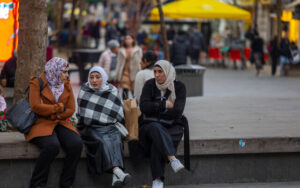 Arab women sit on a bench in central Jerusalem, on January 04, 2022. (Nati Shohat/Flash90)
Arab women sit on a bench in central Jerusalem, on January 04, 2022. (Nati Shohat/Flash90)
New data released Monday on the differences between the Jewish and Arab communities pointed to significant gaps between the two populations, with Arab Israelis earning less income, being more likely to slip into poverty, and dying younger.
The Central Bureau of Statistics (CBS) report, titled “Gaps Between Jews and Arabs,” examined differences in demographic characteristics, standards of living, employment, health, welfare services, personal security, crime, education, transportation and the environment.
The data is from 2020 and 2021.
The report found that in 2021, 76.5 percent of Jewish households could cover their expenses, compared to 53.7% of Arab households.
The same year, the employment rate among Jewish men was 64.4% and among Jewish women 61.6%, while in the Arab community it was 50.4% and 28.3% for men and women, respectively.
The average monthly gross income of a Jewish household in 2021 was 1.6 times that of an Arab home, the CBS said.
The average net income for Jewish homes was NIS 17,779 ($4,919), compared to NIS 11,810 ($3,268) for Arab households.
“The average net financial income per standard person, accepted as a measure of standard of living, in Jewish households was 1.9 times higher than in Arab households,” the report noted.
The average expenses for a Jewish home totaled NIS 15,467 ($4,279) per month, some NIS 1,200 more than the average for Arab homes at NIS 14,282 ($3,951).
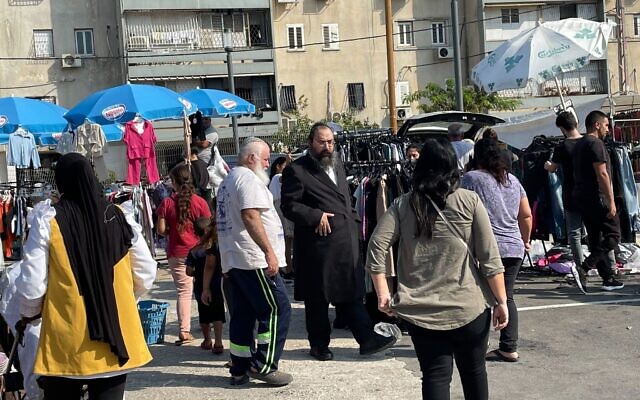
Jews and Arabs shop at the open air market in the central city of Lod on November 1, 2022 (Jeremy Sharon/Times of Israel)<
There are 6.873 million Jews and 1.957 million Arabs in the country, constituting 74% and 21% of the population, respectively.
The Jewish population is growing at a rate of 1.7% per year and the Arab population at a rate of 2.1%. The CBS predicted that by 2048, the population will be 15 million, of which 12 million will be Jews and 3.15 million will be Arabs.
Infant deaths are over 2.5 times higher in the Arab community, with 5.2 fatalities per 1,000 births compared to 2 in the Jewish community.
At the other end of life, Jewish women on average live longer (85.1 years) than their Arab counterparts (81.2 years). Likewise, Jewish men live 81.3 years, more than the 76.3 years on average for Arab men.
Among Jews, 91.5% said that are satisfied with their lives compared to 79.7% among Arabs. Asked if they are satisfied with their economic situation, 70.4% of Jews said they were while 51.1% of Arabs responded affirmatively.
In a reversal of commonly seen trends, 61.9% of Jews said they were satisfied or very satisfied with the balance between work and other aspects of their lives, while a bigger portion of Arabs, 70.9%, felt the same.
Other data showed that among Jews, 36.6% have an academic degree, while 16.2% of Arabs do. Also, 38.3% of Arabs said they have felt discrimination compared to 23.5% of Jews.
“In the last decade, the poverty risk rates in Israel were higher than the poverty risk rates in European Union countries, both at the general level and among population groups at risk of poverty: children aged 0-17, 65 and over, and women. Among Arabs, the risk of poverty was 2.9 times higher than the risk among Jews,” the report said.
Out of every 1,000 Jews, 98.9 are registered with social services, while among Arabs the figure is 156.6 per 1,000.
There was much greater fear among Arabs of being harmed where they live, with 19.5% of Arabs expressing great or very great fear of harm compared to 7.5% among Jews.
As for walking alone at night, 83.3% of Jews said they feel safe compared to 78.7% of Arabs.
Another sharp divergence was in satisfaction with the size of green areas around respondents’ homes, with 70.8% of Jews saying they were satisfied compared to 23.4% of Arabs.
***
Number of Arabs in Israeli Higher Education Grew 79% in Seven Years
Council for Higher Education figures show huge progress but Israeli Arabs still lag far behind Jewish peers in pursuing degrees
Students at the Hebrew University of Jerusalem on January 11, 2018.Credit: Olivier Fitoussi
Arab students accounted for 16.1% of all students in bachelor degree programs last year, up from 10.2% in 2010, the survey found. In master’s programs, the percentage more than doubled to 13% from 6.2% while in doctoral program the figure climbed 60% to 6.3% from 3.9%.
In absolute terms, the number of Arab students climbed 78.5% in the seven years.
Still, even at the bachelor’s level, that meant that Israeli Arabs, who constitute about 21% of the total population, are still underrepresented in higher education. Israeli Arabs constitute an even higher 26% of the population in the age group at which students do undergraduate studies, making their representation especially low.
The only courses of study where Israeli Arabs are enrolled in numbers that reflect their share of the population are in teaching and related medical professions, the report said. Moreover, some sectors of the Arab population haven’t fared as well as others.
“The last few years have seen impressive advances towards integrating Arabs into higher education thanks to a holistic program and the investment of major resources,” said Yaffa Zilbershats, a Bar-Ilan University professor and a member of the council’s planning and budgeting committee.
“However, among the Bedouin population in the Negev the figures are significantly lower. A college education is the key to reducing income gaps and to creating social mobility, for employment and integration into Israeli society,” she said.
A recent article in Haaretz reported that just 850 Bedouin students were enrolled at institutes of higher education in 2016. However, the council has set a goal of increasing that number by 75% over the next five years, budgeting 110 million shekels ($32.3 million) with a special emphasis on math, sciences, engineering, architecture, medicine and para medical professions.
Israeli Arabs have long lagged behind their Jewish peers in obtaining a higher education and the result is that fewer hold jobs or the jobs they do have pay less. Fewer take the exams needed to apply to university and a smaller parentage graduate from high school compared to Jewish students.
Between 2012 and 2016, the Council for Higher Education budgeted 300 million shekels to encourage more Israeli Arabs to pursue a degree. Under Zilbershats, the council’s planning and budget committee decided to extend the program for another six years at a cost of 960 million shekels.
The program targets between 35,000 and 50,000 high school students annually, helping them to prepare for the psychometric exam they need to take for university admission and continues to provide help for them as they pursue a bachelor’s degree. The study, released on Tuesday, was conducted to measure the success of the program to date.
Among institutes of higher education, the gap between Jewish and Arab enrolment was widest at private colleges, where tuition is the highest. Only 12% of Arab students were enrolled at a private college, compared to 15% of all Jewish students.<
On the other hand, 16% of all Arab students were studying at teachers-training colleges in 2016, compared with just 10% of Jewish students. However, teacher’s pay is relatively low and there aren’t enough jobs for all the graduates. As a result, fewer Arab students are enrolling in the programs and opting for other courses of study.<
Arabs made up 20% of all humanities and education students in the 2016-17 year, compared to 12% in 2009-10. The percentage in social sciences, business and management jumped to 15% from 8% and in law to 12% from 8%.<
The University of Haifa had the largest proportion of Israeli Arab students, 41.1%, followed by 22.2% at the Technion Israel Institute of Technology. Ariel, the university in the West bank settlement of the same name, had lowest proportion of Arab students at just 4.7%.<
***
Only 9 Percent of Israeli Arab Men Complete Undergraduate Degrees
Low graduation rate is sharp edge of sword in educational system where Arabs lag far behind their Jewish peers
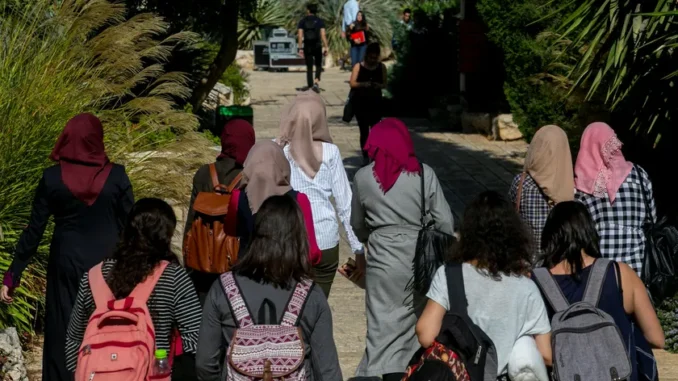 <
<Students begin the school year at the Hebrew University in Jerusalem, October 22, 2017.Credit: Olivier Fitoussi
By Sivan Klingbail and Lior Dattel, HAARETZ Dec 12, 2019
Just days after the international PISA exams showed widening gaps between Israeli Jewish and Arab high school students and the government’s survey on wages revealed a 35 percent gap between the two population groups, new research shows the Jewish-Arab gap at university has also grown sharply over the last two decades.
The study, which was done at the Herzilya Interdisciplinary Center’s Aaron Institute for Economic Policy, found that the Jewish-Arab gap in the rate of graduation from bachelor’s programs at Israeli institutes of higher education widened to 38 percent in 2017, from 23 percent in 2000. The dropout rate is especially high for Arab men, it found.
Education officials have taken pride in the increase in Israeli Arab university and college enrolments over the last decade, but the study found that schools have failed at retaining the students until they completed their degrees.
The researchers say that the programs, which have also been aimed at ultra-Orthodox Jews, are too little and come too late to be effective, and that the system should start dealing with educational issues at the kindergarten and elementary school level. The failure has major implications for Israeli society and the economy, they warn.
“In a situation where only 16 percent of Arab males seek a higher education to begin with and then only 9 percent get their BA – in comparison to half of Jewish males – we can’t be talking about reducing gaps and about equality,” said Dr. Marian Tehawkho, who edited the report.
The Central Bureau of Statistics reported this week that in 2018, Arab men had average gross monthly pay of 8,190 shekels ($2,360), 39.5 percent less than for Jewish men. For women, the gap was 36 percent, with Arab women’s gross pay just 5,720 a month.
The decline in Arab graduation rates come as even as Arabs account for a disproportionate share of Israel’s young – overall Arabs make up 21 percent of Israel’s population but for ages 15-24 they comprise 30 percent. Even if one doesn’t count Haredim among Israel’s Jewish population – which makes sense, since ultra-Orthodox Jews generally shun getting a higher education – than the Arab share of the population is even greater.
Israeli Arab high school graduates are far less likely to complete the bagrut (matriculation) exam – 47 percent versus 70 percent among Israeli Jews – needed to apply to university. Those who do also tend to score less well on the psychometric exam, which most institutes of higher education demand, thereby preventing them from being accepted to the most preferred fields of study. Most graduates of Arab high schools, where the curriculum is taught in Arabic, haven’t acquired sufficient Hebrew fluency to pursue college-level studies.
“The education system acts as if no one cares. If any of the decision makers acted as if it really mattered and set goals that would really advance Arab society, everything would look different. But apparently it’s not important enough,” said Tehawkho.
She said the latest PISA exams – which are administered by the Organization for Economic Cooperation and Development (OECD) and showed that Arab students scored 22-28 percent lower than their Jewish peers – give little cause for optimism about the future.<
“Arab performance declined and the gap with Jews widened. No Arab student excelled in the exam. How is it possible that Arab students, who make up a quarter of the Israeli educational system, had not a single top performer? The figures show there is a serious problem in Israel’s schools,” she said. “If policy makers continue to put their heads in the sand and shun responsibility, we’ll find ourselves in a terrible situation that will impact every aspect of the economy and standard of living of all of Israel’s citizens.”
The performance gap in Israeli school begins at a young age, among other reasons because Arab schools get less funding than other streams. They suffer a huge shortage of quality teachers and a lack of equipment and facilities. The Education Ministry is aware of the problem, which is evidenced not only in the PISA exam but in the locally administered Meitzav exam of elementary school students.
The Education Ministry has sought to address the problem but the budgets dedicated to it have not been enough to effect a change, nor have they been directed at the most critical age groups – kindergartners and high school students. Thus, for example, the average Arab high school spends 25,500 shekels annually per student, 40 percent less than the average for state religious schools and 20 percent less than for non-religious schools.

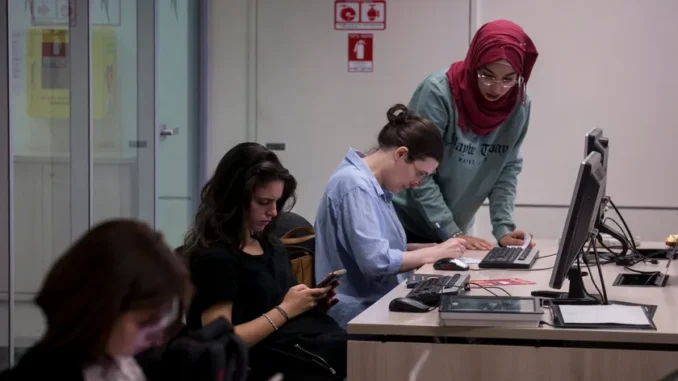
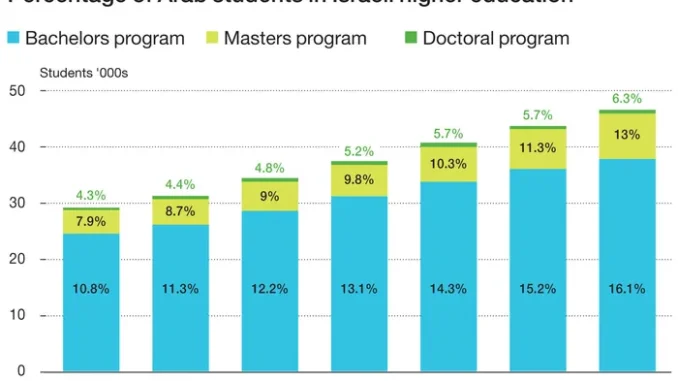


@Bear Such a noisy minority responsible for 70 percent of violent crime, much of it against their fellow Arabs , and then they blame the Jewish state for not preventing them from killing each other! Bibi is going to throw more money at the problem but how can you prevent killers from killing? If Ben-Gvir is able to eliminate the cartels that will help but clan violence, honor killings, the rest of their atavistic nonsense? What can hou do with primitive, warlike savages? Give them more technology and the education to use it?
@Ted, there are more recent numbers than what you posted.
. continue article at https://www.jewishvirtuallibrary.org/latest-population-statistics-for-israel#Diversity%20&%20Growth
@Bear. I trust Ettinger.
https://www.israpundit.org/israeli-jewish-fertility-rate-tops-arab-rate-hits-45-year-high/
The article was written in Oct 2019..He posted a graph on fertility that shows Jews surpassing the arabs in at least 2017 and remained higher to the present.
In addition, “Infant deaths are over 2.5 times higher in the Arab community, with 5.2 fatalities per 1,000 births compared to 2 in the Jewish community.”
Yet this article claims, “The Jewish population is growing at a rate of 1.7% per year and the Arab population at a rate of 2.1%.”. Not possible.
https://www.jns.org/israeli-birth-rate-on-decline-government-data-shows/